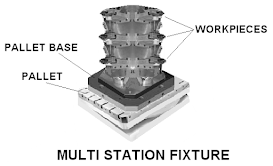During machining operations, it is essential to securely fix and hold both rotating and stationary workpieces to prevent any slippage while cutting. Different types of workpiece mounting systems are used for various machining operations, and workpiece mounting plays a crucial role in achieving accurate positioning, solid support, and strong clamping. Manual workpiece mounting is typically done for conventional machines, while most CNC machines handle it automatically. In the case of a CNC machining center, workpiece mounting is finalized using different types of fixtures, while a chuck mechanism is employed for CNC turning centers. Clamping configurations for metal cutting CNC machines can be categorized into two groups based on the machining operation and the basic construction of the clamping arrangement.
1. Based on Machining Operations
Milling Fixture -
Turning Fixture - Workpiece mounting for turning operations differs from milling operations. In Turning, a centrifugal or rotational force is applied to the workpiece in addition to the cutting load. Hand-operated workpiece mounting for turning machines commonly involves the use of a three or four-jaw chuck, while automatic workpiece mounting is achieved using a quick-acting collet. A power chuck with three or four jaws is usually connected to the machine's spindle and holds cylindrical workpieces for turning operations. Power chucks are typically operated with hydraulic pressure, controlling the movements of the adjustable jaws. The adjustable jaws can be minutely adjusted towards or away from the spindle center, and it is necessary to adjust the clamping jaws according to the diameter of the workpiece. A cylinder piston is used to collectively shift the jaws towards the center of the spindle, applying hydraulic pressure to firmly clamp the workpiece inside the spindle. The cylinder piston moves in the opposite direction to release the workpiece from the spindle.
For CNC turning centers, automatic workpiece mounting is usually accomplished using a quick-acting collet. The collet is positioned inside the spindle and has a slight horizontal movement inward and outward of the spindle. As the collet moves outward, the gap between the metal pieces of the collet increases, and as it moves inward, the gap decreases. When a cylindrical workpiece is inserted into the collet and moved towards the spindle, the three separate metal pieces of the collet hold the workpiece rigidly from the outside. The outward movement of the collet unclamps or releases the workpiece from the spindle. Since the gap between the collet's metal pieces is very small, different-diameter collets are required to clamp workpieces of various diameters inside the spindle. This type of clamping system, often found in turning centers, is equipped with an auto-bar-feeding mechanism.
Grinding Fixture -
Fixture for Drilling, Shaping & Slotting -
2. Based on Basic Fixture Construction
Workpiece fixing systems for
metal-cutting CNC machines can be categorized based on their basic
construction.
Plate Fixture -
Angle plate fixture - This workpiece fixing system is similar to a plate fixture, but the mounting plates are used to clamp the workpieces perpendicular to the machine bed. Refer to the picture showing an angle plate fixture system.
Vice jaw fixture - The vice jaw fixing system is a simple workpiece mounting arrangement occasionally found in CNC machines. The vice is selected based on the size of the workpiece. Refer to the picture of a vice jaw fixing system.
Indexing fixture - Different types of indexing fixtures are used to clamp machining workpieces using mechanisms such as three-jaw chucks, collets, etc. In each step or index movement, the workpiece's fixing arrangement is shifted or positioned to a predefined zone. Refer to the picture showing a three-jaw clamping type simple indexing fixture.
Multi-station fixture - This type of fixture allows multiple workpieces to be machined collectively in a single setup or each part to be machined sequentially. Sometimes, workpieces are positioned in a way that multiple machining processes can be carried out with a single setup. Refer to the picture showing a multi-station fixing system.












No comments:
Post a Comment